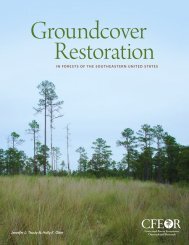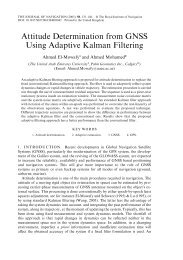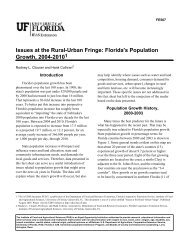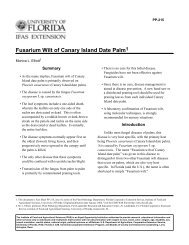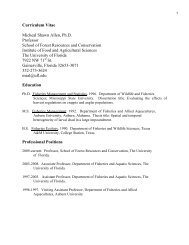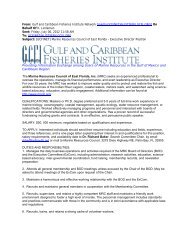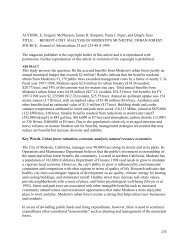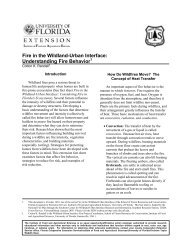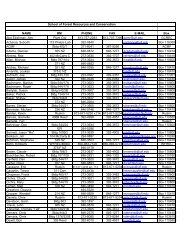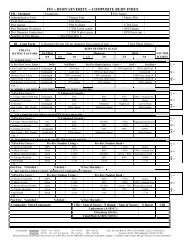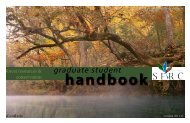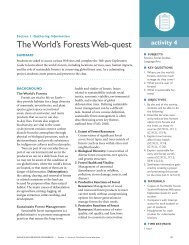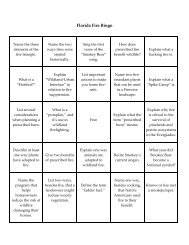Longleaf Pine Forest Restoration & Management - School of Forest ...
Longleaf Pine Forest Restoration & Management - School of Forest ...
Longleaf Pine Forest Restoration & Management - School of Forest ...
Create successful ePaper yourself
Turn your PDF publications into a flip-book with our unique Google optimized e-Paper software.
<strong>Longleaf</strong> <strong>Pine</strong> Regeneration 5<br />
Generally, sites that can be successfully planted can<br />
also be successfully seeded. As with planting, site<br />
preparation methods must control vegetative<br />
competition and expose at least 50% <strong>of</strong> the mineral<br />
soil. Seeds must be in contact with the mineral soil<br />
for germination to take place. Seeds lodged in<br />
non-soil material will probably not become<br />
established.<br />
In general, local seed sources are best. Seed or<br />
seedlings from North and South Carolina tend to<br />
grow poorly when planted on the Florida peninsula<br />
and vice versa. Most genetic improvement work with<br />
longleaf pine is concentrated on breeding for<br />
brown-spot disease resistance and accelerated initial<br />
height growth.<br />
Purchase seeds from a reputable seed dealer.<br />
<strong>Longleaf</strong> seeds should be refrigerated at subfreezing<br />
temperatures until sowing. Sowing can take place in<br />
fall, when moisture is adequate and maximum<br />
daytime temperatures drop below 85 degrees. Seed<br />
can be sown at low cost by broadcast seeding at 3<br />
pounds per acre, or spot seeding (dropping 3 to 5<br />
seeds per spot). Row seeding, at 1 to 2 feet spacing<br />
between seeds, can be used when better control over<br />
spacing and density is desired. Large areas are best<br />
seeded by aircraft which use carefully calibrated<br />
equipment. After establishment (two to three years),<br />
clumps <strong>of</strong> seedlings can be thinned down to one tree.<br />
Natural Regeneration For Even-Aged<br />
Stands<br />
Landowners who already have stands <strong>of</strong> longleaf<br />
pine can take advantage <strong>of</strong> a practical, inexpensive<br />
natural regeneration method known as the<br />
shelterwood system, a natural seeding method<br />
well-suited to the biological requirements <strong>of</strong> this<br />
species. The shelterwood method maximizes<br />
per-acre seed production and yields sufficient needle<br />
litter to fuel fires hot enough to inhibit hardwood<br />
regeneration and to prepare a seed bed. Regular<br />
prescribed burns should be scheduled throughout the<br />
rotation to maintain a low understory. Most <strong>of</strong> the<br />
mature stand is removed at the end <strong>of</strong> the rotation, but<br />
a portion is left standing as a seed source until<br />
regeneration is well established. Success with this<br />
method depends on: (1) a good seed year with<br />
adequate seed supply, (2) a receptive seedbed, (3)<br />
minimal vegetative competition and (4) ample soil<br />
moisture.<br />
The shelterwood system requires 3 cuts that<br />
serve 3 basic purposes: (1) to prepare the stand for<br />
production <strong>of</strong> abundant seed, (2) to modify the<br />
environment in a way that promotes germination and<br />
survival, and (3) to build up the amount and size <strong>of</strong><br />
advance regeneration to ensure a well-distributed<br />
stand following overstory removal.<br />
Preparatory Cut<br />
The preparatory cut is 10 or more years before<br />
the planned harvest date <strong>of</strong> the stand and at least 5<br />
years before the seed cut. This cut is essentially a<br />
thinning which reduces the basal area (BA) <strong>of</strong> the<br />
stand to a maximum <strong>of</strong> 60–70 square feet per acre <strong>of</strong><br />
dominant and codominant pines. This cut promotes<br />
crown development and cone production. Most <strong>of</strong> the<br />
hardwoods not controlled by fire should also be cut at<br />
this time.<br />
Seed Cut<br />
The seed cut is made 5 years prior to the planned<br />
harvest date and leaves no more than 30 square feet<br />
BA per acre <strong>of</strong> dominant trees at least 15 inches<br />
diameter at breast height (dbh), with well-developed<br />
crowns. Trees with evidence <strong>of</strong> past cone production<br />
are favored. Cone production peaks in the range <strong>of</strong><br />
30 to 40 square feet BA per acre, but the lower end <strong>of</strong><br />
this range is preferred because logging-related<br />
seedling losses increase when more trees are removed<br />
in the final cut.<br />
Monitor the cone crop by taking spring binocular<br />
counts <strong>of</strong> both flowers (next year's cone crop) and 1<br />
year-old conelets (this year's cone crop) on selected<br />
sample trees in the regeneration area. These counts<br />
will give an estimate <strong>of</strong> the potential for the cone<br />
crop to regenerate the stand so that the seedbed can<br />
be prepared before the cones open. Generally, few<br />
seeds are produced by trees under 30 years old or<br />
under 10 inches dbh.



